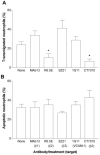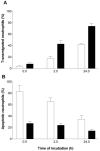Chemokine- and adhesion-dependent survival of neutrophils after transmigration through cytokine-stimulated endothelium
- PMID: 16461737
- PMCID: PMC3119451
- DOI: 10.1189/jlb.0605350
Chemokine- and adhesion-dependent survival of neutrophils after transmigration through cytokine-stimulated endothelium
Abstract
We examined the fate of neutrophils following transmigration through an endothelial monolayer cultured on "Transwell" membrane filters. Treatment of human umbilical vein endothelial cells (HUVEC) with increasing doses of tumor necrosis factor-alpha increased the efficiency of transmigration and markedly reduced apoptosis among the transmigrated neutrophils in a dose-dependent manner. Apoptosis was also inhibited after transmigration of neutrophils through HUVEC stimulated with interleukin (IL)-1beta but not so effectively after chemotaxis through unstimulated HUVEC driven by IL-8 added below the filter. Inhibition of beta2-integrin binding after transmigration or coating the lower chamber with a nonadhesive polymer (polyhydroxyl-ethyl-methacrylate) abrogated neutrophil survival. Although integrin engagement during migration itself was not essential to inhibit apoptosis, activation of neutrophils through CXC chemokine receptors was necessary. Quite brief exposure to the HUVEC (30-120 min) was effective in reducing subsequent apoptosis, although if coincubation with the HUVEC were prolonged, neutrophil apoptosis was reduced further. Neutralization of granulocyte macrophage-colony stimulating factor inhibited this additional effect. Thus, a complex interplay between migration- and activation-dependent signals and adhesive interaction in tissue may combine to effectively prolong the survival of neutrophils recruited during inflammation.
Figures







Similar articles
-
Differing mechanisms of leukocyte recruitment and sensitivity to conditioning by shear stress for endothelial cells treated with tumour necrosis factor-alpha or interleukin-1beta.Br J Pharmacol. 2005 Aug;145(8):1052-61. doi: 10.1038/sj.bjp.0706281. Br J Pharmacol. 2005. PMID: 15912126 Free PMC article.
-
Influence of antiseptic agents on interleukin-8 release and transmigration of polymorphonuclear neutrophils in a human in vitro model of peritonitis.Surg Infect (Larchmt). 2002 Fall;3(3):235-44. doi: 10.1089/109629602761624199. Surg Infect (Larchmt). 2002. PMID: 12542924
-
Migration of neutrophils across endothelial monolayers is stimulated by treatment of the monolayers with interleukin-1 or tumor necrosis factor-alpha.J Immunol. 1989 Nov 15;143(10):3309-17. J Immunol. 1989. PMID: 2553810
-
Granulocyte colony-stimulating factor (G-CSF) increases neutrophil migration across vascular endothelium independent of an effect on adhesion: comparison with granulocyte-macrophage colony-stimulating factor (GM-CSF).Br J Haematol. 1996 Jul;94(1):40-7. doi: 10.1046/j.1365-2141.1996.d01-1752.x. Br J Haematol. 1996. PMID: 8757506
-
Mediator-dependent effects of pentoxifylline on endothelium for transmigration of neutrophils.Immunopharmacology. 1999 Jan;41(1):65-75. doi: 10.1016/s0162-3109(98)00052-6. Immunopharmacology. 1999. PMID: 9950270
Cited by
-
Immune interactions in hepatic fibrosis.Clin Liver Dis. 2008 Nov;12(4):861-82, x. doi: 10.1016/j.cld.2008.07.002. Clin Liver Dis. 2008. PMID: 18984471 Free PMC article. Review.
-
Breakdown of the endothelial barrier function in tumor cell transmigration.Biophys J. 2008 Apr 1;94(7):2832-46. doi: 10.1529/biophysj.107.113613. Epub 2007 Dec 20. Biophys J. 2008. PMID: 18096634 Free PMC article.
-
EphrinA4 plays a critical role in α4 and αL mediated survival of human CLL cells during extravasation.Oncotarget. 2016 Jul 26;7(30):48481-48500. doi: 10.18632/oncotarget.10311. Oncotarget. 2016. PMID: 27374180 Free PMC article.
-
The roles of integrins in function of human neutrophils after their migration through endothelium into interstitial matrix.PLoS One. 2015 Feb 23;10(2):e0118593. doi: 10.1371/journal.pone.0118593. eCollection 2015. PLoS One. 2015. PMID: 25706870 Free PMC article.
-
Role of the endothelium during tumor cell metastasis: is the endothelium a barrier or a promoter for cell invasion and metastasis?J Biophys. 2008;2008:183516. doi: 10.1155/2008/183516. Epub 2009 Mar 5. J Biophys. 2008. PMID: 20107573 Free PMC article.
References
-
- Whyte M, Renshaw S, Lawson R, Bingle C. Apoptosis and the regulation of neutrophil lifespan. Biochem. Soc. Trans. 1999;27:802–807. - PubMed
-
- Savill J, Dransfield I, Gregory C, Haslett C. A blast from the past: clearance of apoptotic cells regulates immune responses. Nat. Rev. Immunol. 2002;2:965–975. - PubMed
-
- Jimenez MF, Watson RW, Parodo J, Evans D, Foster D, Steinberg M, Rotstein OD, Marshall JC. Dysregulated expression of neutrophil apoptosis in the systemic inflammatory response syndrome. Arch. Surg. 1997;132:1263–1269. - PubMed
-
- Ertel W, Keel M, Infanger M, Ungethum U, Steckholzer U, Trentz O. Circulating mediators in serum of injured patients with septic complications inhibit neutrophil apoptosis through up-regulation of protein-tyrosine phosphorylation. J. Trauma. 1998;44:767–775. - PubMed
-
- Coxon A, Rieu P, Barkalow FJ, Askari S, Sharpe AH, von Andrian UH, Arnaout MA, Mayadas TN. A novel role for the β 2 integrin CD11b/CD18 in neutrophil apoptosis: a homeostatic mechanism in inflammation. Immunity. 1996;5:653–666. - PubMed
Publication types
MeSH terms
Substances
Grants and funding
LinkOut - more resources
Full Text Sources

